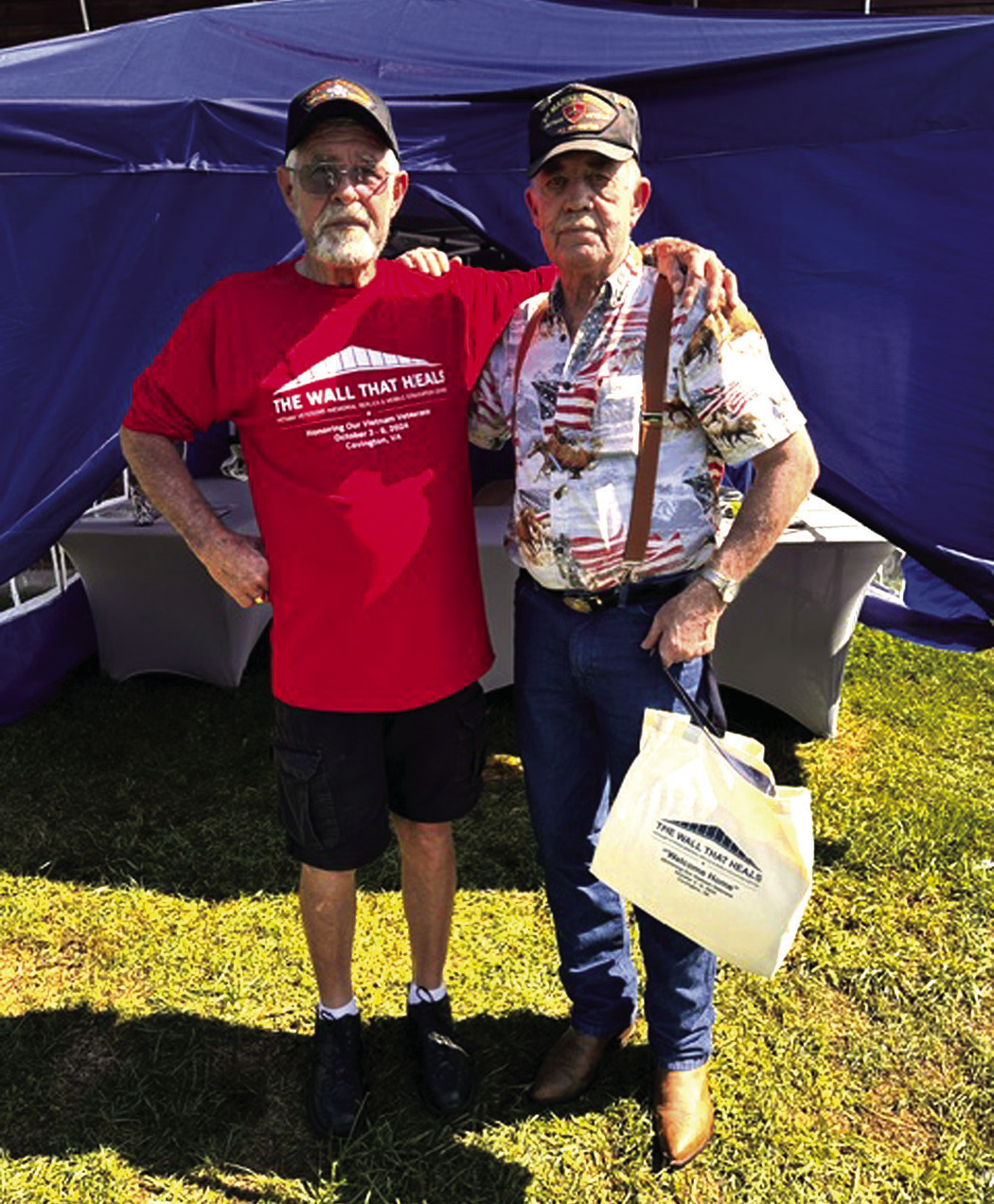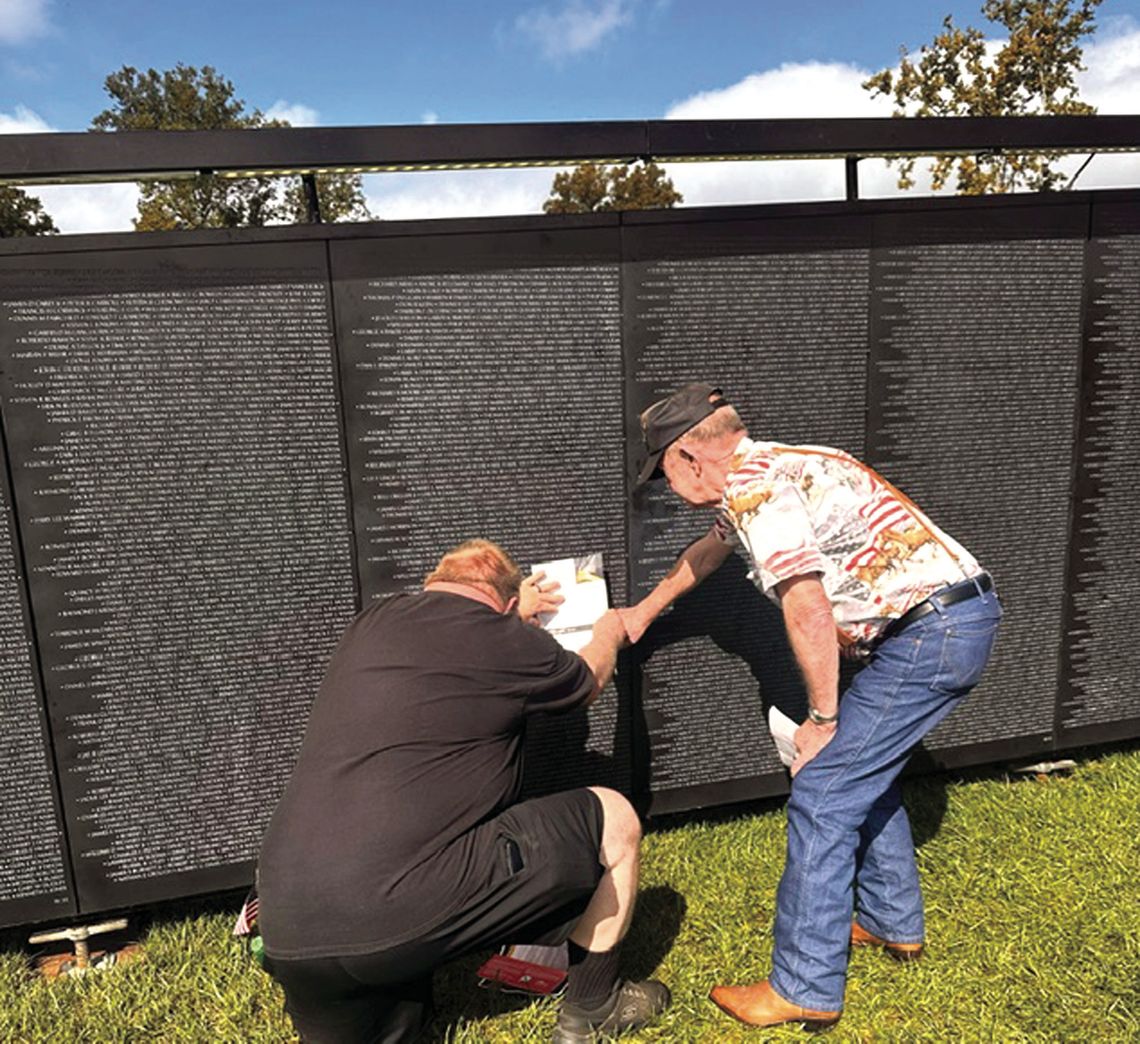Goshen Mayor Visits Wall That Heals
Goshen Mayor Tom McCraw was among the visitors to the Wall That Heals – a mobile replica of the Vietnam Memorial in Washington, D.C. which has toured the country since 1996 – when it stopped in Covington earlier this month. He was accompanied by his son Shane, who lives in West Virginia, as well as friends Loren and Bella Sander of Lexington.
McCraw served for 13 months in Vietnam with the 7th battalion, 9th Regiment, 3rd Division of the U.S. Marine Corps, from May of 1968 to July of 1969. Of the more than 58,000 names on the wall, 41 belong to Marines and Navy corpsmen that Mc-Craw served with.
“It was very emotional,” McCraw said of his visit to the memorial on Oct. 6. “It meant a lot to me. … It’s probably my last chance to visit them. I still talk about it like they’re still here. I promised them I’d never forget them, and I try my best to keep my word on that.”
McCraw was 18 when he arrived in Vietnam and remembers several details about his arrival.
“I remember how the pilot came over the intercom as we were getting ready to land in Da Nang in South Vietnam – we were loaded with about 180some Marines in there – and said ‘We look forward to the day 13 months from now when we’ll come back and take all of you home,’” he recalled. “Of course, we knew that wouldn’t happen.
“I stepped out of the door of the plane and I was immediately soaking wet with sweat,” he contin- ued. “The temperature was like 115 degrees, and the heat bouncing off the runway and all. I said to myself, ‘Tom, I don’t think you’re gonna like this place.’” McCraw spent his tour “out in the boonies” of the Quảng Trị province – at the time the northernmost province in South Vietnam – near the demilitarized zone (DMZ) and the Laotian border. Leeches, he remembers were “a big problem” and he contracted malaria, which he still gets relapses of from time to time. It wasn’t always easy to find drinking water either.
“I remember filling canteens out of a bomb hole that had filled with water,” he said. “You look around and see some of the old farm ponds that are muddy, that’s what we had to drink sometimes. Of course, they gave us a pill to sterilize it, but found out later that same pill can cause cancer.”
McCraw and his fellow Marines were also exposed to Agent Orange, the chemical herbicide and defoliant used to remove vegetation which has since been linked to a number of health issues.
“It’s still working on me. I’ve been lucky to live this long,” McCraw commented. He will celebrate his 75th birthday on Nov. 7.
“There’s a few times I’m lucky I wasn’t killed,” he added. “I guess the good Lord had something else for me to do when I got home, which I’ve tried to do as best I could. To this day, I still think the good Lord and Jesus Christ for bringing me home alive.”
Though he didn’t spend much time in any towns or cities, McCraw did meet some of the Montagnard people, the indigenous Vietmamese who lived in the mountains. He remembers them being “good, dependable people.” It was common practice among the Marines he served with to have a few dollars taken out of each paycheck to go toward helping the civilians. The money, he said, helped fund a hospital and an orphanage near the DMZ.
“It’s proof that Marines are the best fighters in the world, but also we have a lot of humanity [and] concern for civilians,” he said. “They were caught between us and the North Vietnamese. They really went through hell.”
Much of what McCraw saw and experienced during his tour remains with him to this day.
“You can’t describe combat,” he said. “You have to experience it. I live every day with thoughts of it. I still have nightmares after all these years. Not every night, but occasionally.
“We were 18-, 19-year-old kids, but we grew up real fast,” he added. “I went over at 18 and came back probably 60. That’s a little exaggeration, but that’s how it is. You grew up real fast. A lot of us have had trouble with PTSD. When you’re an 18-year-old kid and you have to do the things we had to do – it was either us or them – and the things we saw … It was traumatic times. When someone was wounded or killed, you didn’t have time to have a memorial ceremony. You had to grab your rifle, load them on the helicopters and then keep going. If you stop to think, you might be next. You just had to deal with that.”
During his visit to the mobile wall, McCraw spoke and swapped stories with other veterans who were visiting the wall. He also talked with several civilians who remarked how, when visiting and seeing the names, it “really hits you in the face what that war cost in terms of American boys’ lives.”
The wall was in Covington from Oct. 3 to Oct. 6 before moving on to its next stop in Ridgeville, S.C., where it was on display from Oct. 17 to Oct. 20. It will make two stops in Georgia over the next couple weeks before closing the 2024 tour in Panama City, Fla., Nov. 14-17. McCraw says he wished more people would have been able to see it when it was in Covington.
“I just wish more people could appreciate and try to understand the Vietnam War,” he said. “I would do it again, and most everyone I’ve talked to would do the same thing. We believed in what we were trying to do – keep the South Vietnamese people free.”
Though he has met several veterans who have since returned to Vietnam, McCraw says that’s something he has “no desire” to do.
“I told someone once that the only thing I lost over there was my childhood, and there ain’t no way I could ever go back and get it,” he said. “Most places we were you couldn’t get to anyway, on mountain tops or in deep valleys and so forth.”

DURING his visit to the Wall That Heals mobile Vietnam Memorial on Oct. 6, Goshen Mayor Tom McCraw (right) and his son Shane make a rubbing of the name of one of the 41 Marines and Navy corpsmen McCraw served with in Vietnam from May of 1968 to July of 1969.
.jpg)


